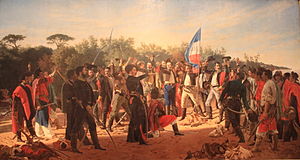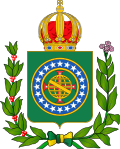Cisplatine War
| Argentina-Brazil War | |||||||
|---|---|---|---|---|---|---|---|
 | |||||||
| |||||||
| Belligerents | |||||||
|
|
of the Río de la Plata | ||||||
| Commanders and leaders | |||||||
|
Brant Lecor |
| ||||||
The Argentina–Brazil War (Portuguese: Guerra da Cisplatina; Spanish: Guerra del Brasil) was an armed conflict over an area known as Banda Oriental or "Eastern Shore" (roughly present-day Uruguay) in the 1820s between the United Provinces of the Río de la Plata and the Empire of Brazil in the aftermath of the United Provinces' emancipation from Spain.
Background

Against the background of rebellions in many parts of the former Viceroyalty of the Río de la Plata and the annexation of Rio Grande do Sul and the Misiones Orientales by Portugal, the Banda Oriental, in turn, revolted against Spanish rule in 1811, led by José Gervasio Artigas.
The area became the Provincia Oriental in 1813 as part of a federal league of provinces, the Liga Federal. The Liga was then invaded by Portugal in 1816 and then dissolved four years later, with its provinces beginning the process of integration into the United Provinces.
In 1821, after the defeat of Artigas in Battle of Tacuarembó and with the support of the local aristocratic families, the Provincia Oriental was re-annexed by Portugal under the name of Província Cisplatina giving the country a strategic position over the Río de la Plata and control over the United Provinces' main port.
After Dom Pedro I declared the independence of Brazil, the Província Cisplatina became part of the Empire of Brazil.
The conflict

Intending to regain control of the Provincia Oriental or Cisplatina, the Confederation of the United Provinces of the Río de la Plata urged the peoples of the Eastern Bank (known as Orientales and led by Juan Antonio Lavalleja) to rise up against the Brazilian domination, giving them political and material support.
With both states economically dependent on the British Empire, the United Kingdom's war mediator George Canning, had a very important role in the conflict and its outcome.
After years of resistance by Oriental separatists, such as Fructuoso Rivera and Lavalleja, the Congress of Deputies of all over the Provincia Oriental met in 1825 in La Florida and declared its independence from the Portuguese and Brazilian empires, reaffirming its belonging to the United Provinces. The response of the imperial government of Brazil was to declare war on the United Provinces.
Emperor Pedro I of Brazil replied by blocking the Río de la Plata and its ports (Buenos Aires and Montevideo). The main base of the Argentine fleet was moved south, first to Ensenada and then to Carmen de Patagones. Brazil attempted to take Carmen de Patagones in 1827, trying to tighten even more the block on the Argentine foreign commerce, but the troops were repelled by the local civilians.
The Argentine army crossed the Río de la Plata placing its camp near Durazno, while General Carlos María de Alvear incursioned in the Brazilian territory. The Viscount of Barbacena, in command of the imperial troops, clashed with the Argentines at the Battle of Ituzaingó.
Pedro I started the land offensive at the end of 1826, gathering the troops in the south of the country, mainly composed of volunteers and some European mercenaries. He had problems gathering an army to resist the Argentinian forces because there were constant popular rebellions in the provinces of the newly independent Brazil, including Rio de Janeiro, its capital at that time.
The lack of men slowed the response capacity against the Orientales now backed up by the Argentine Army. The war took place as many smaller confrontations, with the Battle of Ituzaingó being the only battle of magnitude. Other battles include the Battle of Sarandí and the naval Battle of Monte Santiago.
In 1828 Rivera reconquered the territory of Misiones Orientales.
Aftermath
Given the high cost of the war for both sides and the difficulty of business between the United Kingdom and the United Provinces, conversations for a peace treaty started in Rio de Janeiro. With France and the United Kingdom as arbitrators, and under pressure of the British, the United Provinces of the Río de la Plata and the Brazilian Empire signed the Treaty of Montevideo acknowledging the independence of the Provincia Oriental that became the Estado Oriental del Uruguay. The eastern section territory of Misiones Orientales was given to Brazil.
In Brazil, the loss of the Provincia Cisplatina was another motive to the popular discontent with the government of Dom Pedro I, after a war that was already unpopular. Even though the Guerra da Cisplatina is not considered the main reason for which the emperor abdicated in 1831, it did add to the outcome.
The war resulted in the British Empire obtaining a zone of free commerce controlled by the United Kingdom on the strategically located Río de la Plata.

